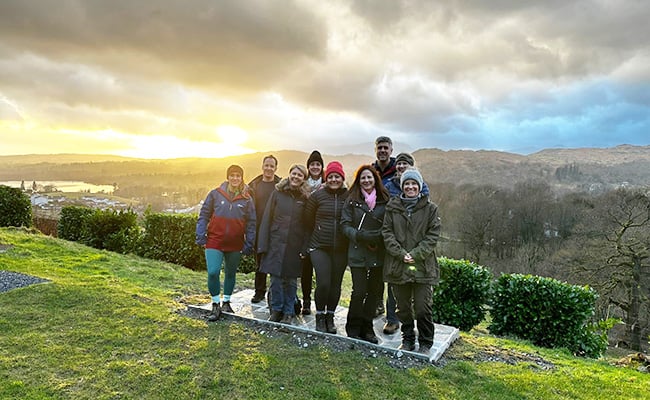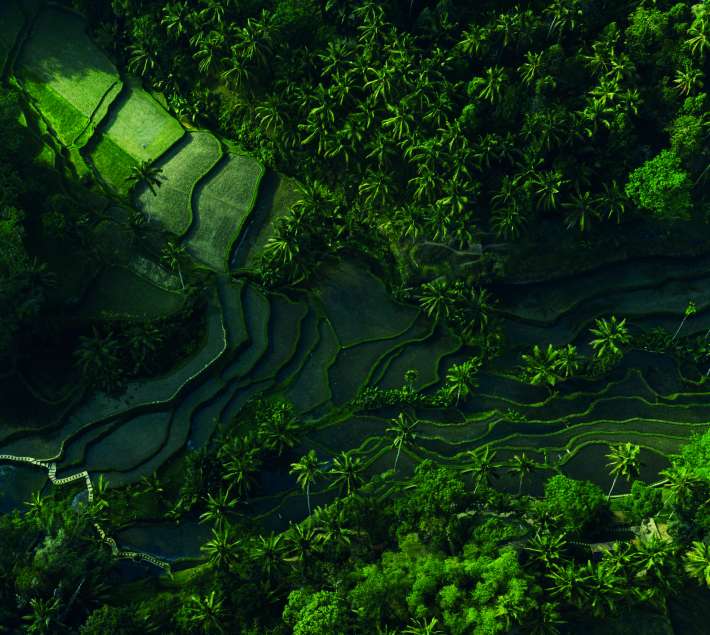Dominic Fitch is head of creative change at Impact
Impact recently welcomed a group of senior learning professionals to bring their complex challenges to a one-day immersive retreat in the heart of the Lake District. In this article Dom reflects on what made the experience so special.
Register your interest in our next executive retreat
A transformative experience
Our event kicked off in the midst of storm Isha. There was flooding on the roads, travel disruptions, cancellations, and howling winds of up to 90mph.
Fast forward 24 hours, and we left the retreat feeling refreshed and calm, with the sun setting through the breaking clouds and reflecting on the lake.
If this was an A-Level literary critique of our experience I would talk about pathetic fallacy. A term coined by John Ruskin to talk about the way an artist, writer or poet uses the weather and nature to reflect the human condition. It was a very popular device with the Romantic poets, Wordsworth, Shelly and Keats.
There was something very powerful about the way we arrived in an adventurous windswept storm and left feeling calm and renewed. So how did we get to this point?

Storytelling and human connection
This retreat was designed for our participants to take time out, pause and reflect on how they are working. It was an opportunity to gain clarity and different perspectives on their current working challenges. We invited participants to take these challenges on a literal and metaphorical journey – leaving their homes and places of work and joining us for a day to sit with these challenges and move with them through different experiences we had designed.
We began by telling stories of who we are and the memorable moments in our lives. Part of this was sharing a significant object that helped to tell our story to others. It was a humbling to listen to people’s hopes, dreams, and past experiences. We connected, empathised, listened, and opened our hearts to each other. One participant reflected during dinner: “I’ve just met some of you and feel like I know you better than most of my team.” It really brought to life the power of stories and what can happen when we focus on enhancing the experience of interacting with one another.
At Impact, we believe in the power and importance of human experience in our organisations, and it is something we constantly look to enhance when we partner with clients. The most important thing for human-centred organisations is that they focus on constantly improving the quality and effectiveness of people-to people interactions – both internally with employees, and externally with customers.
The power of noticing
The following day, we set off on a journey to our headquarters, Kelsick. This was a 6km walk across fells, through forests, and over rivers (thankfully the rain had stopped by this point). During the walk, we invited participants to reflect on a series of questions and provocations designed to help them articulate their current challenge.
One way we did this was through an audio journey, involving pauses at different places and listening through headphones as we walked. This is a core aspect of many Impact programmes. Intentionally heightening the senses is a powerful way to help participants focus on the environment they are in and, more importantly, to tune into how they are noticing and experiencing that environment.
We can think about noticing as both an inner and an outer state:
- Inward awareness is the ability to recognise and connect deeply to your emotions, what are you feeling and sensing, and how are you attending to your inner sense of self.
- Outward awareness is our propensity to notice the intricate details of the moment we are in and how we relate with others. This will influence how we respond to the world around us.
When we heighten these senses and become aware of how we notice, we can start to reframe our experiences of the world and see things differently. In doing so, we transform our sense of self and how we relate with the world. This is the start of personal transformation, growth and change.
Another way we practiced this during our walk was by connecting what we were noticing with the weather, the natural world, and the turning of the seasons.
During a solo reflection by a river, one participant commented that they’d never really stopped and appreciated nature in this way before. They were often outside walking their dog, exercising but rarely taking time to pause and appreciate the details of where they were.
“And this our life, exempt from public haunt, finds tongues in trees, books in the running brooks, sermons in stones, and good in everything.” Shakespeare – As You Like It
Present moment awareness – truly appreciating where we were, where we had been, and where we wanted to go – was an important part of our time together. We work with a lot with organisations in this way, encouraging them to focus on the current reality they are in rather than being tethered to the past and old ways of working.
On our walk, this practice of awareness and reflection was enhanced beautifully by the time of year. Winter was on its way out and spring was teasing us with its arrival, snowdrops and daffodils trumpeting in the start of something new. What do you need to welcome in and what do you need to let go of?
New perspectives on existing challenges
Once at Kelsick, the core focus of our work was to continue to share our current challenges and focus on different vantage points to understand them from.
The method we used for this was to physically sculpt the challenges with modelling clay. Key to this experience was the opportunity for participants to literally see their challenge laid in front of them, and to view it from different perspectives. By walking around the tables and asking a series of questions, we helped participants to reframe their current position into a future potential, and a new way of seeing themselves and their approach to the challenges they were facing.
The retreat ended with a solo walk to waterfalls reflecting on the impact the day had had on them, and the impact they wanted to make this year in their lives and through their work.
As the sun started to set and we gathered for a final photograph one participant commented, “I can’t believe this has just been 24 hours. It’s amazing what can happen when we take time to do this.”
